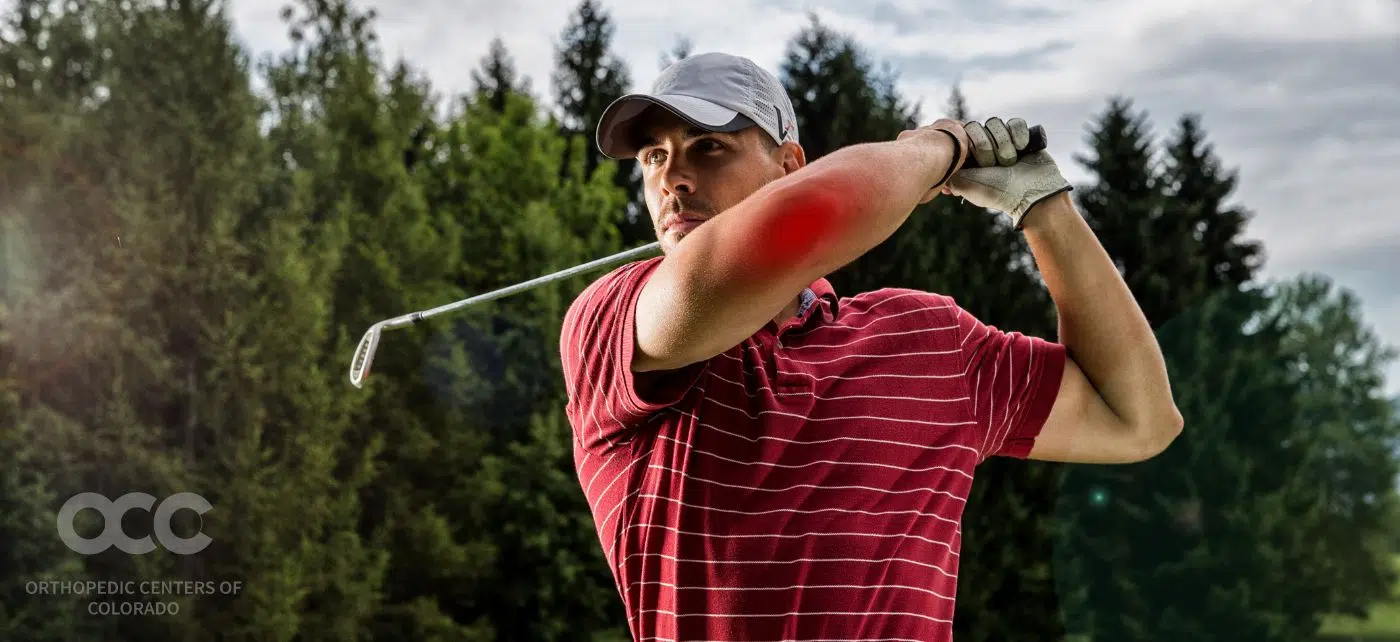Few people understand what golfer’s elbow is until they experience pain and other symptoms that affect how they live, interfering with the things they need to do to get through each day. Golfer’s elbow can be more than a nuisance that can keep someone off the greens or away from the job. While the tendency is to ignore it, thinking it will resolve on its own, it is imperative to get a full orthopedic evaluation. The highly skilled specialists at Advanced Orthopedic in Denver, Parker, and Aurora, Colorado, are trained to identify golfer’s elbow and create unique treatment plans for each patient that will keep golfer’s elbow from becoming worse.
GOLFER’S ELBOW OVERVIEW
Golfer’s elbow isn’t as well-known as tennis elbow, perhaps because golfer’s elbow is less common. Less than 1% of the population has golfer’s elbow. It affects men and women between the ages of 45-64. Women are more likely than men to develop golfer’s elbow. It isn’t necessary to be a golfer for golfer’s elbow to occur. Approximately 90% of people with golfer’s elbow develop it doing something other than playing sports.
ABOUT THE ELBOW
The elbow is one of the largest joints in the body and one of the joints we use most. In conjunction with the shoulder joint and wrist, the elbow gives the arm much of its versatility as well as structure and durability. The elbow swings 180 degrees in one direction to extend the forearm, and it also helps turn the forearm at the point where the parallel bones in the forearm—the radius on the thumb side of the arm and the ulna on the pinky finger side—meet. The elbow’s anatomy includes many components—including bones, ligaments, tendons, muscles, and nerves— working together to maintain the activities of the arm.
WHAT IS GOLFER’S ELBOW?
Golfer’s elbow, also known as medial epicondylitis, is a form of tendonitis that causes pain and inflammation in the tendons connecting your forearm and elbow. When you repeatedly use your wrist and arm to bend, grasp or twist things, your tendons develop tiny tears that can cause wrist, elbow, and forearm pain. Golfer’s elbow is similar to tennis elbow which occurs on the outside of the elbow. Tennis players and others who repeatedly use their wrists or clench their fingers can also develop golfer’s elbow. Golfer’s elbow usually affects the dominant arm. For example, right-handed people develop golfer’s elbow in their right arm.
CAUSES
The damage is typically related to excess or repeated stress — especially forceful wrist and finger motions. Things that can lead to golfer’s elbow besides golfing include:
- Sports that use a racket, like tennis. Improper technique, especially with the backhand, can cause injury to the tendon, as can excessive use of topspin or using a racket that’s too small or heavy.
- Sports that rely on lots of throwing movements, like archery, baseball, bowling, football, javelin throwing, and softball. Pitching a ball incorrectly, for example, can lead to golfer’s elbow, too. It’s sometimes called pitcher’s elbow or baseball elbow.
- Improper weight training technique. Curling the wrists during a biceps exercise can overload the elbow muscles and tendons.
- Too little warmup or poor conditioning in any sport.
- Forceful, repetitive occupational movements that occur in fields such as construction, plumbing, and carpentry.
- Hefting a loaded food tray, pounding away at the computer keyboard, raking, or painting can all lead to golfer’s elbow.
SYMPTOMS
Symptoms might include stiffness in the elbow, tenderness and pain, usually on the inner side of the elbow or the inner side of the forearm, tingling or numbness in the fingers (usually the ring and little fingers), decreased grip strength, and pain when trying to make a fist. Symptoms can take weeks or months to develop, and the pain might seem worse first thing in the morning.
WHEN TO SEE A DOCTOR
Left untreated, golfer’s elbow could cause permanent damage like limiting the elbow’s range of motion, causing chronic pain, and weakening your grip. One should seek immediate medical attention for golfer’s elbow if the area of pain is also inflamed and the discomfort is accompanied by a fever. You should also obtain prompt medical care if you cannot bend your elbow or are experiencing numbness or weakness in your hand.
NON-SURGICAL TREATMENTS
In most cases, a doctor will recommend the least invasive treatments possible. This might include icing the elbow for 15 to 20 minutes three or four times daily. Try resting the injured elbow from aggravating activities. Your doctor might recommend wearing a brace or suggest exercises for stretching and strengthening. Other physical or occupational therapy practices can be helpful, too. For pain, your doctor may recommend an oral NSAID (nonsteroidal anti-inflammatory drug) like aspirin, ibuprofen, or naproxen to reduce pain and swelling. Topical medication may help, as well. Getting an injection of a corticosteroid or painkiller like lidocaine in the elbow may relieve pain and swelling in the short term.
WHEN IS SURGERY INDICATED?
Surgery is seldom necessary. But if signs and symptoms don’t respond to conservative treatment in six to 12 months, surgery might be an option. Open surgery is usually performed, although an arthroscopic technique may also be used. The goal of the surgery is to remove the damaged tendon that’s causing pain and reattach a healthy tendon in its place. In most cases, surgery for golfer’s elbow is done on an outpatient basis, so recovery starts at home the same day as having the procedure. A soft cast can be used to keep the elbow still, giving the tendon a chance to heal.
GOLFER’S ELBOW; GETTING THE RIGHT DIAGNOSIS
Getting the right diagnosis for elbow pain is key to getting the right treatment. Because non-golfers can suffer the effects of golfer’s elbow, it is important they seek help from highly trained orthopedic specialists like those at Advanced Orthopedics in Denver, Parker, and Aurora, Colorado. Golfer’s elbow is usually diagnosed based on your medical history and a thorough physical exam. To start, they’ll ask you specific questions; “is the pain constant? How severe is it? Do tasks that use your elbow—lifting, gripping, carrying, typing, even shaking hands—trigger pain? Are your symptoms affecting your ability to complete daily tasks? Are they affecting your sleep?” The caring doctors at Advanced Orthopedics are thorough and detailed in their examination. To evaluate pain and stiffness, the doctor might apply pressure to the affected area or ask you to move your elbow, wrist, and fingers in various ways. An X-ray can help the doctor rule out other causes of elbow pain, such as fractures or arthritis. Other tests might include an MRI, ultrasound, or CT scan. At Advanced Orthopedics, you’ll get answers, individual attention, treatments to alleviate pain, and an ongoing plan to take care of your elbow without giving up your favorite activities.













